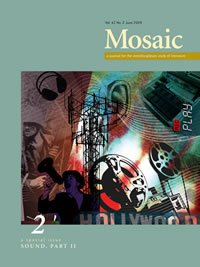Issue 42.2
Overview

Special Issue: Sound, Part 2
Published: June 2009
Add the March 2009 issue 'Sound, Part 1' to your order and receive 30% off both issues! Note: the discount will not appear in your cart until you check out.
View the issue introduction or see the issue summary and contents below.
12 essays, totalling 224 pages
$24.95 CAD
In this, the second of a two-part Mosaic special issue on Sound, “voice” emerges as a prominent theme, approached through studies of voice recording, queer vocality, memory, archive, sound poetry, iteration, and the figure of Echo. The issue also includes essays on “sound images” in silent film, music and narrative, and sonic elements in a BBC TV science-fiction series.
A Return to the Scene of the Postmodern: Ezra Pound ReadingSarah Parry This essay documents the publication of Ezra Pound’s voice on LP as a supplement to his literary texts and wartime radiobroadcasts. It also theorizes the disposition of the post-war spoken word industry as a product of unconscious media logics, including mediation as containment, mediation as memorialization, and mediation as supplementarity. | |
Invisible Voices: Archiving Sound as Sight in Marcel Beyer’s Karnau TapesIan Thomas Fleishman This essay probes the topical emphasis on acoustic concerns within Marcel Beyer's 1995 novel, The Karnau Tapes, in order to demonstrate how transitory, auditory elements are repeatedly documented by visual and ostensibly more permanent models that fail to contain them. | |
How to Have Race without a Body: The Mass-Reproduced Voice and Modern Identity in H.D.’s “Two Americans”Genevieve Abravanel H.D.’s little-known story “Two Americans” traces the impact of the mechanically reproduced voice on conceptions of racial and national identity. Quintessentially human and yet ineffably ghostly, of the body and yet disembodied, the mechanically reproduced voice echoes the paradoxical condition of the alienated modern subject. | |
Sounding Off: Performing Ritual Revolt in Olive Senior’s “Meditation on Yellow”Michael A. Bucknor In this essay, attention to Olive Senior’s “sound portraits” encourages the expansion of our critical preoccupation with verbal reference to include verbal rhythm. Her “curse” poem “Meditation on Yellow” demonstrates the value of this critical approach to illustrating the guerrilla potential of Afro-Caribbean-Canadian embodied cultural retention. | |
The Roar of The Crowd: Urban Noise and Anti-Noise in Silent CinemaDennis Hanlon The Crowd uses “sound-suspense images” —a technique unique to the late silent period—to critically represent the urban noisescape. This essay details the technological, ideological, and aesthetic developments that made these images possible, and it considers the codification of Hollywood sound practices that soon made them obsolete. | |
Resonances of Echo: A Derridean AllegoryPleshette DeArmitt This essay examines Derrida’s gloss on the Ovidian tale of Echo and Narcissus. By exploring Derrida’s allegory of Echo, found in many later texts and interviews, from The Work of Mourning and Rogues to the movie Derrida, the essay articulates a deconstructive notion of the “self” through an exploration of voice as a process of iteration and ex-appropriation, which must take the form of a loving affirmation. | |
Alternative Vocalities: Listening Awry to Peter Maxwell Davies’ Eight Songs for a Mad KingAdrian Curtin This essay analyzes the use of extended-voice technique and “extreme” vocalizations in Peter Maxwell Davies’s avant-garde music-theatre work Eight Songs for a Mad King. Using poststructuralist and musicological theories of voice, the essay makes the case for a conception of “queer vocality” that disrupts and subverts socio-cultural and aesthetic norms. | |
Why the Cybermen Stomp: Sound in the New Doctor WhoAnne Cranny-Francis This essay analyses the meanings of sound in the Cyberman double episode of the BBC Television science-fiction series Doctor Who, “Rise of the Cybermen” and “Age of Steel.” Arguing that all sound in a text contributes to its meanings, the essay focuses on relationships between humans and technology. | |
Limitless voice(s), Intensive Bodies: Henri Chopin's Poetics of ExpansionCédric Jamet Focusing on a sound poem by Henri Chopin, this essay reflects on Chopin’s approach to the body through the voice. His creative use of sound technologies, combined with his original take on live performance, lead to the poetic experience of a fluid, libidinal body, detached from the mediation of language. | |
Dissonant Desires: Staceyann Chin and the Queer Politics of a Jamaican AccentKelly Baker Josephs This essay examines the tension between accents and meaning in speech by focusing on performance poet Staceyann Chin, a Jamaican lesbian now living in the United States. The essay explores the politics of national accents, the conflicts between oral performance and printed poetry, and the tensions surrounding Caribbean homophobia. | |
Saartjie Baartman’s Speech and the Sounds of National IdentificationStephen Lucasi This essay explores the dynamics of national identification represented in two literary recreations of Saartjie Baartman (the “Hottentot Venus”). Long a symbol of visual demarcations between Africans and Europeans, Baartman here represents the possibility of national identifications imagined through sonorous and acoustic forms of resemblance and difference. | |
Musical Imaginaries in Vikram Seth’s An Equal MusicHazel Smith Using the concept of the musical imaginary to bring together an unorthodox mix of cultural and psychoanalytic theory, music cognition, and recent musicology, this essay examines the way Vikram Seth, in An Equal Music, narrativizes the real of musical meaning and its repression through “normalization” in professional music-making. |